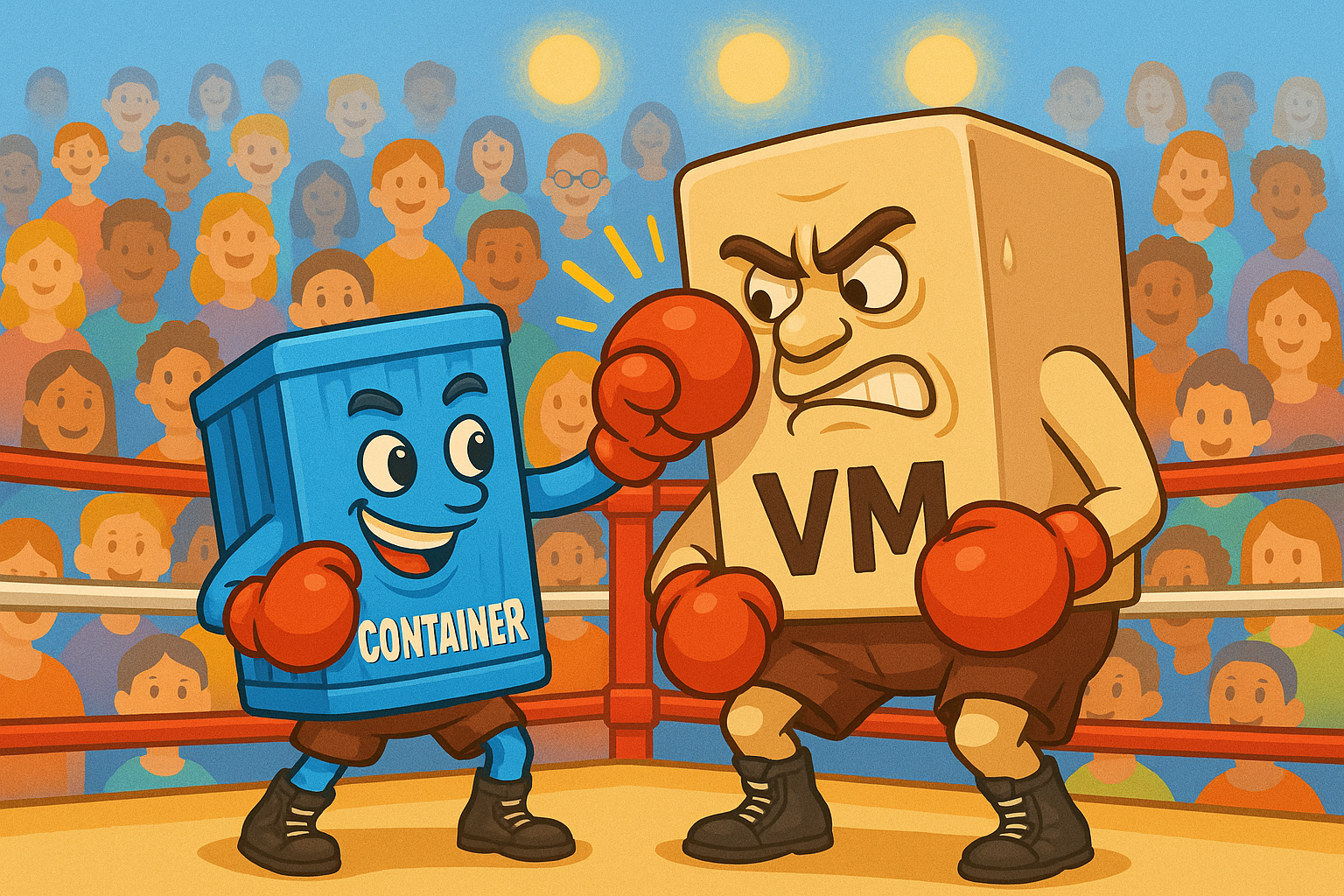Beyond the Hype: Rediscovering Why Containers Won

Ever feel like you missed the memo on why everyone’s obsessed with containers? Like, you know Docker exists, you’ve probably used it, but you’re still wondering why it became the thing that basically took over infrastructure?
I was having this exact conversation with a colleague last week. They asked me, “Why don’t we just run each app on its own tiny VM?” And honestly? It’s a fair question. Let me walk you through why containers didn’t just win by accident-they solved real problems that were driving us all crazy.
This post is for anyone who’s ever thought: “Okay, containers are everywhere, but why exactly?”
🚂 The Real Difference: Containers vs VMs
Here’s the thing-containers and VMs both do isolation, but they’re solving it in completely different ways. Think of it like this:
| What you get | Containers (Docker & friends) | Virtual Machines |
|---|---|---|
| How they isolate stuff | Share the kernel, separate processes | Each gets its own full OS |
| How fast they start | Seconds (sometimes milliseconds!) | Minutes (ugh) |
| Memory footprint | Megabytes | Gigabytes |
| How many per server | Tons | Limited by all that OS overhead |
| “It works on my machine” | Actually solved this | Still a problem sometimes |
| Security | Good, but shared kernel = shared risk | Stronger isolation |
I remember when we used to spin up VMs for every little service. Want to test something? Wait 5 minutes for the VM to boot. Need to scale up? Hope you’ve got enough RAM for all those guest operating systems.
🏎️ Why Containers Feel Like Magic (Spoiler: They’re Not Magic)
The first time I ran docker run hello-world and it just… worked in seconds, I was hooked. But why are they so much faster?
Think about it this way: When you boot a VM, you’re basically starting up a whole computer inside your computer. The hypervisor has to pretend to be hardware, the guest OS has to go through its entire boot process, initialize all its services-it’s a lot.
Containers? They’re just processes. Really well-isolated processes, but still just processes. They use your existing kernel and just sandbox everything else. So you get:
- Instant startup (I’m talking milliseconds to seconds)
- Way less memory waste (no duplicate OS copies eating RAM)
- More bang for your buck (run way more stuff on the same hardware)
- Smaller cloud bills (seriously, this adds up)

🔒 The Security Reality Check
Let’s be honest here-containers aren’t some magical security fortress. They share the host kernel, which means if someone finds a kernel exploit, they could potentially break out of all containers on that host.
VMs? Each one has its own OS and runs through a hypervisor. That’s like having separate apartments vs. separate rooms with really good locks.
- Containers: Super fast and efficient, but if the building has a problem, everyone feels it
- VMs: Slower and heavier, but each one is its own fortress
This is why a lot of smart teams run containers inside VMs. You get the speed and efficiency of containers with an extra layer of VM isolation. Best of both worlds, if you can afford the complexity.
🚀 The “It Works on My Machine” Problem (Finally Solved!)
You know that feeling when your code works perfectly on your laptop but explodes in production? Yeah, containers basically ended that nightmare.
I used to spend hours debugging environment differences. “Oh, you’re running Python 3.8 but production has 3.7.” “Wait, did anyone install that dependency on the staging server?” “Why is this library behaving differently on Ubuntu vs CentOS?”
Containers package everything together-your app, its dependencies, the runtime, even specific library versions. When you ship a container, you’re shipping the exact environment your code was tested in.
This revolutionized how we build and deploy software:
- No more environment drift between dev, staging, and production
- CI/CD pipelines that actually work consistently
- Easy rollbacks (just swap container images)
- Language mixing (Python microservice next to a Go service? No problem)
DevOps teams love this because they can deploy and test stuff way faster. As one wise person said: “Containerization complements DevOps because software can be deployed and tested faster, improving feedback loops.” Octopus Deploy
⚖️ Why CFOs Love Containers Too
Here’s something that sold containers to the business side: they save money. Real money.
When you can run 10x more applications on the same hardware, that means fewer servers to buy, maintain, and power. Your cloud bills get smaller because you’re not paying for a bunch of idle operating systems sitting around doing nothing.
I saw one study that said IBM found containers can cut server maintenance, administration, and facilities costs by about 75% compared to VMs. Now, take that with a grain of salt because these studies always sound too good to be true, but the basic math makes sense-less waste means lower costs. NAMU Tech

🛠️ Kubernetes: When Containers Got Superpowers
Containers by themselves are cool, but when you combine them with orchestration platforms like Kubernetes? That’s when things get really interesting.
Kubernetes basically gives you:
- Auto-scaling (traffic spike? More containers appear automatically)
- Self-healing (container crashes? New one starts up)
- Zero-downtime deployments (rolling updates like a boss)
- Service discovery (containers can find each other without hardcoded IPs)
The adoption numbers are pretty crazy-apparently 96% of organizations are using Kubernetes now. That’s not just hype; that’s because it actually solves real operational problems. Edge Delta
🧩 When You Should Still Use VMs (Yes, Really)
Look, I’m not here to tell you containers are the answer to everything. Sometimes VMs still make more sense:
- Legacy apps that were built assuming they own a whole machine
- Compliance requirements that demand hardware-level isolation
- Mixed OS environments (need Windows and Linux on the same host? VMs got you)
- Really untrusted workloads (like running customer code)
Most companies I know run a hybrid setup. Containers for new, cloud-native stuff. VMs for legacy systems and security-sensitive workloads. And often, containers running inside VMs for that extra security layer.
🔮 What’s Next: The Lines Are Blurring
The future is getting weird in a good way. New technologies like AWS Firecracker and serverless containers (AWS Fargate, Google Cloud Run) are basically giving you VM-level security with container-level performance.
There are also these things called micro-VMs that start almost as fast as containers but give you better isolation. It’s like getting the best of both worlds without having to choose.
We’re moving toward a world where you don’t really have to pick sides-you just pick the right tool for each job.
📚 Want to Dig Deeper?
If you want to explore more about this stuff, here are some resources I found helpful:
- Netdata: Container vs VM - Which Is Better Option For You
- Veeam: Virtualization vs. Containerization: Key Differences
- Open Telekom Cloud: Container or virtual machine – which is more suitable for your project?
- Cloud Security Alliance: Are Containers More Secure Than VMs?
- Edge Delta: Latest Kubernetes Adoption Statistics: Global Insights and Analysis for 2025
- Octopus Deploy: The benefits of containerization
- CircleCI: Benefits of containerization
- Cloud Kinetics: CI/CD Pipeline For Container-Based Workloads: A DevOps Strategy
- NAMU Tech: Cost benefit Analysis: Virtual Machines vs Containers
- Google Cloud: The future of infrastructure will be containerized
- Trianz: Benefits of Containerization: Accelerate your SDLC
- Northflank: Your containers aren’t isolated. Here’s why that’s a problem.
- NanoVMs: The Problem with Container Isolation and Zero CVE Images
- The New Stack: What We Wish We Knew About Container Security
✅ So, Why Did Containers Win?
Containers didn’t win because of marketing or hype. They won because they solved real problems that were making our lives miserable:
- The “works on my machine” problem
- Slow deployment cycles
- Expensive, wasteful infrastructure
- Environment inconsistencies
- Scaling headaches
Are they perfect? Nope. But they’re the right tool for most modern applications, and when you combine them with orchestration platforms, they become incredibly powerful.
The smartest teams I know use containers where they shine, VMs where they must, and aren’t religious about either one. It’s all about picking the right tool for the job.
What’s your experience with containers vs VMs? Any war stories or “aha” moments? I’d love to hear about them! 🤘